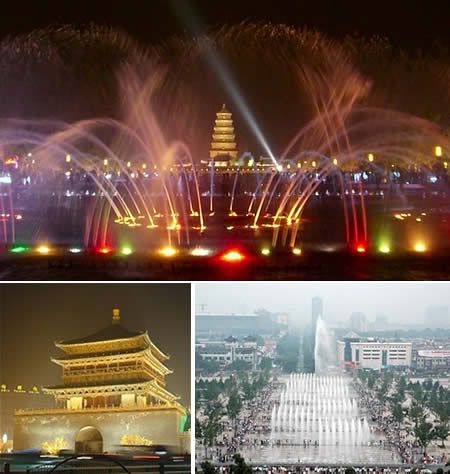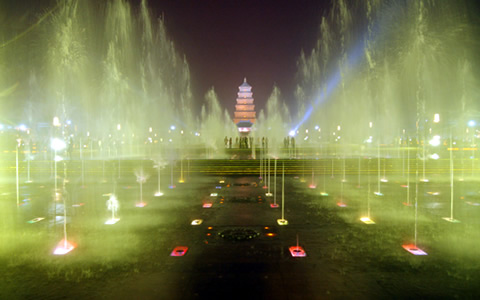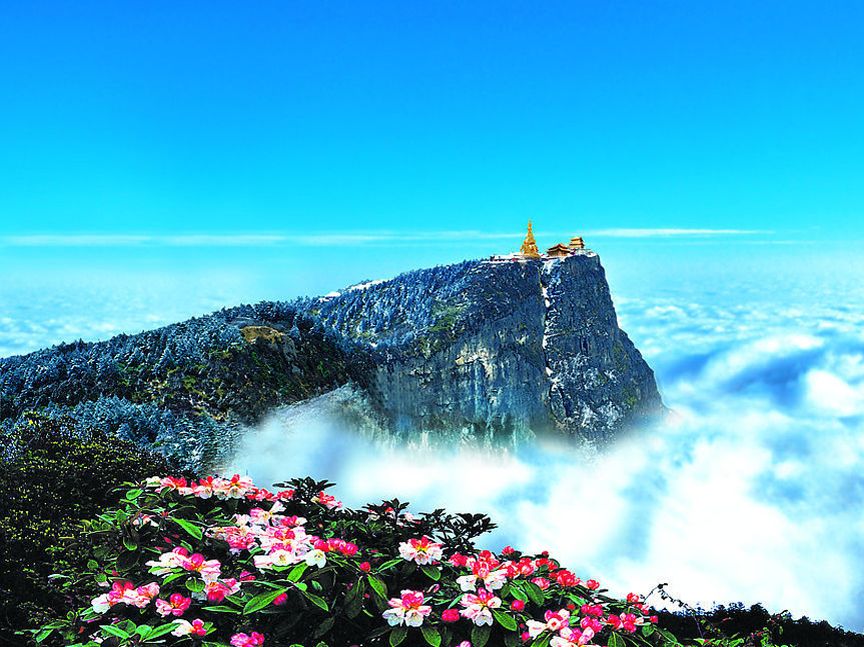-
IP addresses are NOT logged in this forum so there's no point asking. Please note that this forum is full of homophobes, racists, lunatics, schizophrenics & absolute nut jobs with a smattering of geniuses, Chinese chauvinists, Moderate Muslims and last but not least a couple of "know-it-alls" constantly sprouting their dubious wisdom. If you believe that content generated by unsavory characters might cause you offense PLEASE LEAVE NOW! Sammyboy Admin and Staff are not responsible for your hurt feelings should you choose to read any of the content here. The OTHER forum is HERE so please stop asking.
You are using an out of date browser. It may not display this or other websites correctly.
You should upgrade or use an alternative browser.
You should upgrade or use an alternative browser.
China - Land of the Dragons
- Thread starter kopiuncle
- Start date
Songsanling Monastery was built to symbolize an 8 petaled lotus flower. It has 8 temples, each with the Dharma Wheel and 2 deer. The main assembly hall can hold 1600 monks. Zhongdian.
Being the largest Tibetan Buddhist monastery in Yunnan, Songzanlin Monastery, also known as Guihua Monastery, is one of the famous monasteries in the Kang region. It is located near Shangri -La County, at the foot of Foping Mountain.
Construction of the monastery began in 1679 and was completed two years later. The monastery seems like a group of ancient castles and is composed of two lamaseries, Zhacang and Jikang. The gilded copper roof endows the monastery with strong Tibetan features and the 108 (an auspicious number in Buddhism) columns downstairs also feature the it with characteristics of Han nationality. The main halls in the monastery are magnificent, and on both the left and right sides are wonderful frescos, depicting Buddhist tales and legends. The inside-halls are exquisite with cloisters running through. The cloisters are all decorated with beautiful sculptures and consummate frescos.
The monastery is full of treasures. There are a lot of golden figures of Buddha josses, golden lamps, Tibetan lections, silver censers and so on. All of these are wonderful collections accumulated from each dynasty. They are precious productions made by people of both Tibet nationality and Han nationality.
Songzanlin Monastery has another alias - 'the little Potala Palace ', so named because the whole monastery is in the traditional style with mysterious atmosphere. In 1679, Dalailama chose this place by divination, and it went on to become the uppermost public place in Yunan which features the particular local characteristics. Annually, the Gedong Festival is celebrated here by the Tibetans. Pious believers, with their knees and foreheads knocking the ground at every step, come here to pray.



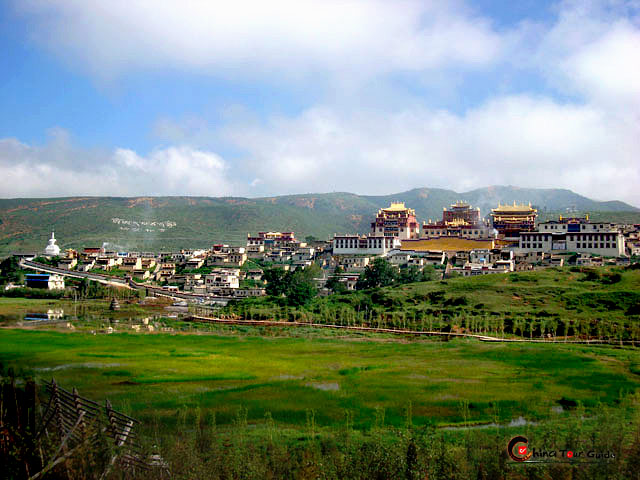

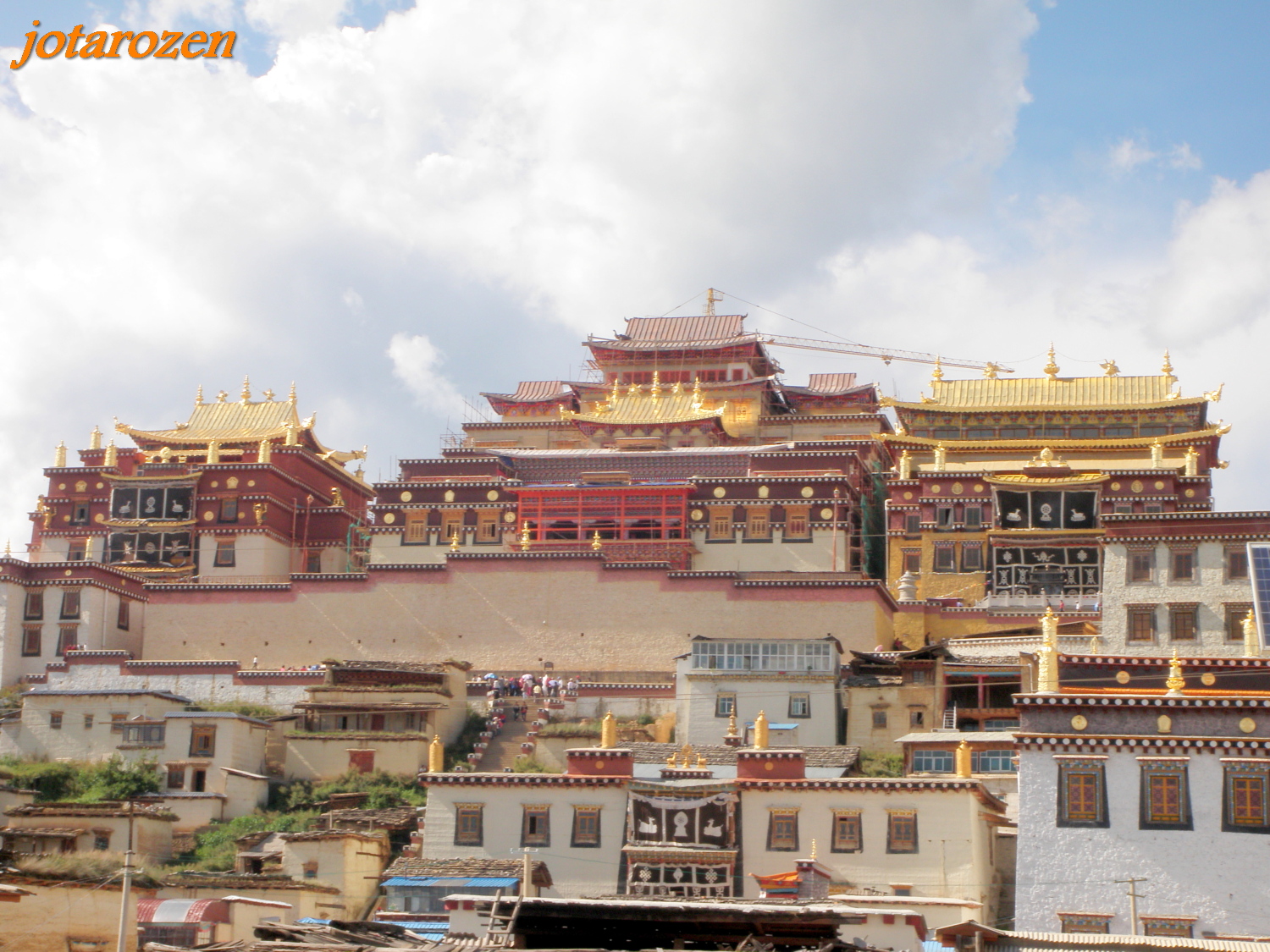
The monastery is situated in the high altitude region over 3,300 meters (about 10,827 feet) high. It snows even in August, and has a rainy season that runs from June through September. Therefore, spring and summer are the best seasons for people to visit it.
Being the largest Tibetan Buddhist monastery in Yunnan, Songzanlin Monastery, also known as Guihua Monastery, is one of the famous monasteries in the Kang region. It is located near Shangri -La County, at the foot of Foping Mountain.
Construction of the monastery began in 1679 and was completed two years later. The monastery seems like a group of ancient castles and is composed of two lamaseries, Zhacang and Jikang. The gilded copper roof endows the monastery with strong Tibetan features and the 108 (an auspicious number in Buddhism) columns downstairs also feature the it with characteristics of Han nationality. The main halls in the monastery are magnificent, and on both the left and right sides are wonderful frescos, depicting Buddhist tales and legends. The inside-halls are exquisite with cloisters running through. The cloisters are all decorated with beautiful sculptures and consummate frescos.
The monastery is full of treasures. There are a lot of golden figures of Buddha josses, golden lamps, Tibetan lections, silver censers and so on. All of these are wonderful collections accumulated from each dynasty. They are precious productions made by people of both Tibet nationality and Han nationality.
Songzanlin Monastery has another alias - 'the little Potala Palace ', so named because the whole monastery is in the traditional style with mysterious atmosphere. In 1679, Dalailama chose this place by divination, and it went on to become the uppermost public place in Yunan which features the particular local characteristics. Annually, the Gedong Festival is celebrated here by the Tibetans. Pious believers, with their knees and foreheads knocking the ground at every step, come here to pray.






The monastery is situated in the high altitude region over 3,300 meters (about 10,827 feet) high. It snows even in August, and has a rainy season that runs from June through September. Therefore, spring and summer are the best seasons for people to visit it.
Last edited:


500 steps to reach the top level...a spiritual passage at a height of 3400 metres....no easy task...but bearable and can be done if you have the will and the passion to do it......at this height, every step is an effort because of the thin air....you have to walk slowly and with full concentration: mindfulness to reach the desired level.....patience and perseverance...

Last edited:

another wonderful place to visit when you are in Xian...The Forest Stone Steles Museum....

Forest of Stone Steles Museum in Xian...
Once the site of the Temple of Confucius during the Northern Song dynasty (960-1127), the Forest of Stone Steles Museum is situated on Sanxue Street, near the south gate of Xian City Wall. It was initially established in 1087A.D.. when some precious stone steles were moved here for safe keeping, including the 'Classic on Filial Piety' written by Emperor Xuanzong in 745A.D. and 'the Kaicheng Stone Steles' carved in 837A.D.. With an area of 31,000 square meters, the Forest of Stone Steles used to be the principal museum for Shaanxi Province since 1944. Then because of the large number of stone steles, it was officially named as the Forest of Stone Steles Museum in 1992.
With 900 years of history, this treasure house holds a large collection of the earliest stone steles of different periods, from the Han Dynasty to the Qing Dynasty. All together, there are 3,000 steles and the museum is divided into seven exhibitions halls, which mainly display the works of calligraphy, painting and historical records. All of these record some achievements in the development of the Chinese culture and reflect the historical facts of the cultural exchanges between China and other countries.
The Muslim Quarters in Xian....Just as its name implies, Moslem Street is the hub of the Moslem community in Xian City, Shaanxi Province. Located beside the Drum Tower, it is about 500 meters (about 547 yards) long from south to north. This street is paved with dark colored stone with green trees providing heavy shade during summer; the buildings on both sides of the street are modeled on the styles of both the Ming (1368-1644) and the Qing Dynasties (1644-1911). Some of the constructions are restaurants; while others are stores. But here there is one thing in common: the owners are all Moslems.
Moslem Street has a long history. It is said that in olden days, foreign diplomatic envoys and merchants lived here then they married and had children, so gradually the population increased. Today, most of the inhabitants of Moslem Street are the descendants of those immigrants. All the Moslems here are the pious and devout followers of Islam so they form a tight knit community, which maintains its own culture and traditions to this day even in such a modern society.People here are very familiar with each other because they were companions when they were children and then they grew to adults together and still then one after another they got married and had their own children. As time goes on, definitely they will become older and older or even pass by together.






Moslem Street has a long history. It is said that in olden days, foreign diplomatic envoys and merchants lived here then they married and had children, so gradually the population increased. Today, most of the inhabitants of Moslem Street are the descendants of those immigrants. All the Moslems here are the pious and devout followers of Islam so they form a tight knit community, which maintains its own culture and traditions to this day even in such a modern society.People here are very familiar with each other because they were companions when they were children and then they grew to adults together and still then one after another they got married and had their own children. As time goes on, definitely they will become older and older or even pass by together.






- Joined
- Sep 11, 2012
- Messages
- 2,842
- Points
- 0
beautiful, fascinating and enchanting city...XIAN..














- Joined
- Sep 11, 2012
- Messages
- 2,842
- Points
- 0

Xian Ancient Wall...
Xian - the capital city of Shanxi Province
Located in the middle reaches of the Yellow River, Shaanxi is one of the birthplaces of the Chinese nation. There, early Chinese settlers developed a great civilization comparable with that of ancient Egypt, India and the area lying between Tigris and Euphrates rivers. Van, also known as Chang'an l(Eternal Peace) in ancient times, has a history of 3,100 years.
In Xi'an, there are 41 universities and colleges, 3,300 research institutions and technological development centres. The city also has some 50 state-level laboratories and testing centres which are capable of absorbing, digesting and transplanting domestic and overseas advanced technologies. As a result, the city has produced significant scientific achievements. It is in Xi'an that China's first engine for carrier rocket, China's first satellite-borne computer and China's first integrated circuit came into being.....

the ancient and the developing modern - side by side...

The Drum Tower....in Xian
The Drum Tower is located northwest of the Bell Tower of Xian, across the Bell Tower and Drum Tower Square. Both of them are called the 'sister buildings' or 'morning bell and dark drum'. In ancient China, especially from the Yuan Dynasty (1271-1368), the drums were used to signal the running of time and on occasion were used as an alarm in emergency situations.
The Drum Tower in Xian was initially built in 1380 during the reign of Emperor Hongwu of the Ming Dynasty (1368-1644), and was renovated twice in 1699 and 1740 in the Qing Dynasty (1644-1911). It is a two-storied post and panel structure, 34 meters (about 112 feet) high and 52.6 meters (about 172 feet) long from east to west as well as 38 meters (about 124 feet) wide from north to south. The architecture style of the Drum Tower is a combination of the styles of the Tang Dynasty (618-907) and the Qing Dynasty. However, the Drum Tower also has some innovative features. For example, it should be mentioned that there is no iron nail used anywhere in the Drum Tower.
Arriving at the Drum Tower you will see that there is an arched doorway in the centre of the south and north walls, doorway being 6 meters (about 20 feet) in both height and width. The north entrance leads to Beiyuan Men and south to the West Avenue. Visitors can go upstairs to the second floor, and enjoy the views around the Drum Tower. Meanwhile, you will notice that there are twenty-four drums in the north and south sides of the Drum Tower. These drums stand for the Twenty-four Solar Terms which is a kind of weather calendar created by the Chinese ancients in order to guide the agricultural production.
In modern times, the Drum Tower is not used as a timer any more, but there are some new attractions for visitors to enjoy. In the year of 1996, a new drum, covered by a whole piece of cowhide was given a place on the Drum Tower. It is the biggest drum in China at present. What is more, visitors will enjoy musical performances on the Drum Tower. These performances will enlighten one on the power of ancient Chinese culture.
When you finish visiting the Drum Tower, you may round off your trip, by tasting a number of delicious snacks of Shaanxi in the Moslem Street (Huimin Jie) adjacent to the Drum Tower.
- Joined
- Sep 11, 2012
- Messages
- 2,842
- Points
- 0

The Bell Tower...in Xian....
The Bell Tower, is a stately traditional building, that marks the geographical center of the ancient capital. From this important landmark extend East, South, West and North Streets, connecting the Tower to the East, South, West and North Gates of the City Wall of the Ming Dynasty.
The wooden tower, which is the largest and best-preserved of its kind in China, is 36 meters (118 feet) high. It stands on a brick base 35.5 meters (116.4 feet) long and 8.6 meters (28.2 feet) high on each side. During the Ming Dynasty, Xian was an important military town in Northwest China, a fact that is reflected in the size and historic significance of its tower.
The tower was built in 1384 by Emperor Zhu Yuanzhang as a way to dominate the surrounding countryside and provide early warning of attack by rival rulers.
The tower has three layers of eaves but only two stories. Inside, a staircase spirals up. The grey bricks of the square base, the dark green glazed tiles on the eaves, gold-plating on the roof and gilded color painting make the tower a colorful and dramatic masterpiece of Ming-style architecture. In addition to enhancing the beauty of the building, the three layers of eaves reduce the impact of rain on the building.
On the second floor, a plaque set in the west wall records the relocation of the tower in 1582. When it was first built in 1384, it stood near the Drum Tower of Xian on the central axis of the city, and continued to mark the center of the city since Tang Dynasty and the following the Five Dynasties and the Song and Yuan Dynasties. As the city grew, however, the geographical center changed. Therefore, in 1582, the Tower was moved 1,000 meters (3,280 feet) east of the original site. Except for the base, all parts are original, and history tells us that the relocation was accomplished quickly and inexpensively, making it a truly notable achievement in the architectural history in China.
Originally, the northwest corner of the tower housed the famous Jingyun Bell from the Tang Dynasty. Legend has it that although nothing had changed in the tower, the Jingyun Bell fell silent during the Ming Dynasty, so the current bell, a much smaller one weighing only 5 tons, was cast. The original Jingyun Bell can now be seen in Forest of Stone Steles Museum.
The engravings on the doors of the Tower reflect the decorative fashion of Ming and Qing Dynasties, recounting popular stories of ancient China.
On each side of the base, there is an arched door 6 meters (19.6feet) high. In the past, vehicles were allowed to pass through the arches and under the tower, but as the city has grown the volume of traffic has become too great, so a bright, spacious pedestrian subway has been constructed under the tower. The entrance to the tower is from this subway.
A fenced-in area around the tower is planted with grass and flowers. In early spring, the tender plum blossoms and bright new grass surrounding the old tower provide a harmonious contrast. Not far from the Tower, modern shopping malls and a brightly decorated square reveal the prosperity of the city. When night falls, lanterns hung from the eaves illuminate the tower, making it even more enchanting.
The Bell Tower definitely deserves a visit on your trip to Xian.
Another great landmark in Xian - the Big Wild Goose Pagoda,one of the holy places in Buddhism...



The famous monk...Hsuan Tsang... who started his incredible journey to India in search of Buddhist knowledge....
In A.D. 629, the Chinese monk Hsuan Tsang left the Tang dynasty capital and traveled west—on foot, on horseback and by camel and elephant—to India and returned in A.D. 645 with 700 Buddhist texts from which Chinese deepened their understanding of Buddhism. Hsuan Tsang is remembered as a great scholar for his translations from Sanskrit to Chinese but also for his descriptions if the places he visited—the great Silk Road cities of Kashgar and Samarkand and the great stone Buddha in Bamiyan, Afghanistan. His trip was the inspiration for Journey to the West, a story widely regarded as one of the great novels of Chinese literature. [Book: "Ultimate Journey, Retracing the Path of an Ancient Buddhist Monk Who Crossed Asia in Search of Enlightenment" by Richard Bernstein (Alfred A. Knopf)]
Towards the end of the Tang dynasty, Chinese Emperors began to favor Taoism over Buddhism;. monks and nuns were secularized; temples and libraries were destroyed. Buddhism remained overshadowed by Taoism and Confucianism until it experienced a revival in the 11th century
As the symbol of the old-line Xian, Big Wild Goose Pagoda (Dayan Pagoda) is a well-preserved ancient building and a holy place for Buddhists. It is located in the southern suburb of Xian City, about 4 kilometers (2.49 miles) from the downtown of the city. Standing in the Da Ci'en Temple complex, it attracts numerous visitors for its fame in the Buddhist religion, its simple but appealing style of construction, and its new square in front of the temple. It is rated as a National Key Cultural Relic Preserve as well as an AAAA Tourist Attraction.
This attraction can be divided into three parts: the Big Wild Goose Pagoda, the Da Ci'en Temple, and the North Square of Big Wild Goose Pagod
Originally built in 652 during the reign of Emperor Gaozong of the Tang Dynasty (618-907), it functioned to collect Buddhist materials that were taken from India by the hierarch Xuanzang.
Xuanzang started off from Chang'an (the ancient Xian), along the Silk Road and through deserts, finally arriving in India, the cradle of Buddhism. Enduring 17 years and traversing 100 countries, he obtained Buddha figures, 657 kinds of sutras, and several Buddha relics. Having gotten the permission of Emperor Gaozong (628-683), Xuanzang, as the first abbot of Da Ci'en Temple, supervised the building of a pagoda inside it. With the support of royalty, he asked 50 hierarchs into the temple to translate Sanskrit in sutras into Chinese, totaling 1,335 volumes, which heralded a new era in the history of translation. Based on the journey to India, he also wrote a book entitled 'Pilgrimage to the West' in the Tang Dynasty, to which scholars attached great importance.



The famous monk...Hsuan Tsang... who started his incredible journey to India in search of Buddhist knowledge....
In A.D. 629, the Chinese monk Hsuan Tsang left the Tang dynasty capital and traveled west—on foot, on horseback and by camel and elephant—to India and returned in A.D. 645 with 700 Buddhist texts from which Chinese deepened their understanding of Buddhism. Hsuan Tsang is remembered as a great scholar for his translations from Sanskrit to Chinese but also for his descriptions if the places he visited—the great Silk Road cities of Kashgar and Samarkand and the great stone Buddha in Bamiyan, Afghanistan. His trip was the inspiration for Journey to the West, a story widely regarded as one of the great novels of Chinese literature. [Book: "Ultimate Journey, Retracing the Path of an Ancient Buddhist Monk Who Crossed Asia in Search of Enlightenment" by Richard Bernstein (Alfred A. Knopf)]
Towards the end of the Tang dynasty, Chinese Emperors began to favor Taoism over Buddhism;. monks and nuns were secularized; temples and libraries were destroyed. Buddhism remained overshadowed by Taoism and Confucianism until it experienced a revival in the 11th century
As the symbol of the old-line Xian, Big Wild Goose Pagoda (Dayan Pagoda) is a well-preserved ancient building and a holy place for Buddhists. It is located in the southern suburb of Xian City, about 4 kilometers (2.49 miles) from the downtown of the city. Standing in the Da Ci'en Temple complex, it attracts numerous visitors for its fame in the Buddhist religion, its simple but appealing style of construction, and its new square in front of the temple. It is rated as a National Key Cultural Relic Preserve as well as an AAAA Tourist Attraction.
This attraction can be divided into three parts: the Big Wild Goose Pagoda, the Da Ci'en Temple, and the North Square of Big Wild Goose Pagod
Originally built in 652 during the reign of Emperor Gaozong of the Tang Dynasty (618-907), it functioned to collect Buddhist materials that were taken from India by the hierarch Xuanzang.
Xuanzang started off from Chang'an (the ancient Xian), along the Silk Road and through deserts, finally arriving in India, the cradle of Buddhism. Enduring 17 years and traversing 100 countries, he obtained Buddha figures, 657 kinds of sutras, and several Buddha relics. Having gotten the permission of Emperor Gaozong (628-683), Xuanzang, as the first abbot of Da Ci'en Temple, supervised the building of a pagoda inside it. With the support of royalty, he asked 50 hierarchs into the temple to translate Sanskrit in sutras into Chinese, totaling 1,335 volumes, which heralded a new era in the history of translation. Based on the journey to India, he also wrote a book entitled 'Pilgrimage to the West' in the Tang Dynasty, to which scholars attached great importance.
Dearest Uncle , how are you , long time already .
wahwahwah very beautiful pictures of China.
Uncle , can teach me how to attached these beautiful pictures ?
You tube got teach boh ?
tk u .
sorry boy boy, i did not reply to you. my humble apologies. yes, you can learn from You Tube. take care....thanks.
Re: The Stone Forest Of Kunming.....
If you are in Xian, don't forget to visit the UNESCO site, The Terracotta Warriors!!!



The Terracotta Army or the "Terra Cotta Warriors and Horses", is a collection of terracotta sculptures depicting the armies of Qin Shi Huang, the first Emperor of China. It is a form of funerary art buried with the emperor in 210–209 BC and whose purpose was to protect the emperor in his afterlife.
The figures, dating from around the late third century BC, were discovered in 1974 by local farmers in Lintong District, Xi'an, Shaanxi province. The figures vary in height according to their roles, with the tallest being the generals. The figures include warriors, chariots and horses. Current estimates are that in the three pits containing the Terracotta Army there were over 8,000 soldiers, 130 chariots with 520 horses and 150 cavalry horses, the majority of which are still buried in the pits near by Qin Shi Huang's mausoleum.Other terracotta non-military figures were also found in other pits and they include officials, acrobats, strongmen and musicians.
If you are in Xian, don't forget to visit the UNESCO site, The Terracotta Warriors!!!



The Terracotta Army or the "Terra Cotta Warriors and Horses", is a collection of terracotta sculptures depicting the armies of Qin Shi Huang, the first Emperor of China. It is a form of funerary art buried with the emperor in 210–209 BC and whose purpose was to protect the emperor in his afterlife.
The figures, dating from around the late third century BC, were discovered in 1974 by local farmers in Lintong District, Xi'an, Shaanxi province. The figures vary in height according to their roles, with the tallest being the generals. The figures include warriors, chariots and horses. Current estimates are that in the three pits containing the Terracotta Army there were over 8,000 soldiers, 130 chariots with 520 horses and 150 cavalry horses, the majority of which are still buried in the pits near by Qin Shi Huang's mausoleum.Other terracotta non-military figures were also found in other pits and they include officials, acrobats, strongmen and musicians.
Last edited:
Re: The Stone Forest Of Kunming.....
The Golden Summit, covering an area of 16 square kilometers (6 square miles) was built by Zhu Mo, the son of Emperor Zhu Yuanzhang in Ming Dynasty (1368- A.D.1644 A.D.), who believed in Buddhism and denoted golds to build the Golden Hall of Da'e Mt., so the tiles, the pillars and the windows of the Golden Hall are all made of gold and bronzes. On a sunny day, everything in the hall looks like gold that comes form “Golden Summit”, shining brightly in the sun. It is the biggest pilgrimage center of Chinese Buddhism and is credited with the masterpiece in the world. It is really a wonderful place for the visitors to visit, watching the clouds roll in and out and going into the world that’s far away from the Earth.
The Golden Summit, covering an area of 16 square kilometers (6 square miles) was built by Zhu Mo, the son of Emperor Zhu Yuanzhang in Ming Dynasty (1368- A.D.1644 A.D.), who believed in Buddhism and denoted golds to build the Golden Hall of Da'e Mt., so the tiles, the pillars and the windows of the Golden Hall are all made of gold and bronzes. On a sunny day, everything in the hall looks like gold that comes form “Golden Summit”, shining brightly in the sun. It is the biggest pilgrimage center of Chinese Buddhism and is credited with the masterpiece in the world. It is really a wonderful place for the visitors to visit, watching the clouds roll in and out and going into the world that’s far away from the Earth.
Last edited:
Re: The Stone Forest Of Kunming.....




Shenzhen (Chinese: 深圳; pinyin: Shēnzhèn; Mandarin pronunciation: [ʂə́ntʂə̂n]) is a major city in the south of Southern China's Guangdong Province, situated immediately north of Hong Kong. The area became China's first—and one of the most successful—Special Economic Zones (SEZs). It currently also holds sub-provincial administrative status, with powers slightly less than a province.
Shenzhen's modern cityscape is the result of the vibrant economy made possible by rapid foreign investment since the institution of the policy of "reform and opening" establishment of the SEZ in late 1979, before which it was only a small village. Both Chinese and foreign nationals have invested enormous amounts of money in the Shenzhen SEZ. More than US$30 billion in foreign investment has gone into both foreign-owned and joint ventures, at first mainly in manufacturing but more recently in the service industries as well. Shenzhen is now considered one of the fastest-growing cities in the world.
You can get anything here at rock bottom prices....anything goes. You have to bargain...some good leather stuff can be bargained from RMB 600 to 60!!! and they are aggressive sales people.....all they want is a sales!!!....if you don't buy after you have agreed to the price, be prepared for all sorts of vulgarities....sometimes even some punches for the guys!!!
Being southern mainland China's major financial centre, Shenzhen is home to the Shenzhen Stock Exchange as well as the headquarters of numerous high-tech companies. Shenzhen is also one of the busiest container ports in China.




Shenzhen (Chinese: 深圳; pinyin: Shēnzhèn; Mandarin pronunciation: [ʂə́ntʂə̂n]) is a major city in the south of Southern China's Guangdong Province, situated immediately north of Hong Kong. The area became China's first—and one of the most successful—Special Economic Zones (SEZs). It currently also holds sub-provincial administrative status, with powers slightly less than a province.
Shenzhen's modern cityscape is the result of the vibrant economy made possible by rapid foreign investment since the institution of the policy of "reform and opening" establishment of the SEZ in late 1979, before which it was only a small village. Both Chinese and foreign nationals have invested enormous amounts of money in the Shenzhen SEZ. More than US$30 billion in foreign investment has gone into both foreign-owned and joint ventures, at first mainly in manufacturing but more recently in the service industries as well. Shenzhen is now considered one of the fastest-growing cities in the world.
You can get anything here at rock bottom prices....anything goes. You have to bargain...some good leather stuff can be bargained from RMB 600 to 60!!! and they are aggressive sales people.....all they want is a sales!!!....if you don't buy after you have agreed to the price, be prepared for all sorts of vulgarities....sometimes even some punches for the guys!!!
Being southern mainland China's major financial centre, Shenzhen is home to the Shenzhen Stock Exchange as well as the headquarters of numerous high-tech companies. Shenzhen is also one of the busiest container ports in China.
- Joined
- Sep 15, 2008
- Messages
- 6,578
- Points
- 113
Re: The Stone Forest Of Kunming.....
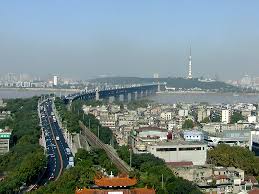



Wuhan (simplified Chinese: 武汉; traditional Chinese: 武漢; pinyin: Wǔhàn [wùxân] ( listen)) is the capital of Hubei province, People's Republic of China, and is the most populous city in Central China.It lies in the eastern Jianghan Plain at the intersection of the middle reaches of the Yangtze and Han rivers. Arising out of the conglomeration of three cities, Wuchang, Hankou, and Hanyang, Wuhan is known as "the nine provinces' leading thoroughfare"; it is a major transportation hub, with dozens of railways, roads and expressways passing through the city. Because of its key role in domestic transportation, Wuhan was sometimes referred to as the "Chicago of China."
It is recognized as the political, economic, financial, cultural, educational and transportation center of central China.The city of Wuhan, first termed as such in 1927, has a population of 10,020,000 people (as of 2011),with about 6,434,373 residents in its urban area. In the 1920s, Wuhan was the national capital of a leftist Kuomintang (KMT) government led by Wang Jingwei in opposition to Chiang Kai-shek,[7] as well as wartime capital in 1937.


Wuhan (simplified Chinese: 武汉; traditional Chinese: 武漢; pinyin: Wǔhàn [wùxân] ( listen)) is the capital of Hubei province, People's Republic of China, and is the most populous city in Central China.It lies in the eastern Jianghan Plain at the intersection of the middle reaches of the Yangtze and Han rivers. Arising out of the conglomeration of three cities, Wuchang, Hankou, and Hanyang, Wuhan is known as "the nine provinces' leading thoroughfare"; it is a major transportation hub, with dozens of railways, roads and expressways passing through the city. Because of its key role in domestic transportation, Wuhan was sometimes referred to as the "Chicago of China."
It is recognized as the political, economic, financial, cultural, educational and transportation center of central China.The city of Wuhan, first termed as such in 1927, has a population of 10,020,000 people (as of 2011),with about 6,434,373 residents in its urban area. In the 1920s, Wuhan was the national capital of a leftist Kuomintang (KMT) government led by Wang Jingwei in opposition to Chiang Kai-shek,[7] as well as wartime capital in 1937.
- Joined
- Sep 15, 2008
- Messages
- 6,578
- Points
- 113
Re: The Stone Forest Of Kunming.....







.jpg)









.jpg)


- Joined
- Sep 15, 2008
- Messages
- 6,578
- Points
- 113
Re: The Stone Forest Of Kunming.....

The Hanging Temple, also Hanging Monastery or Xuankong Temple (simplified Chinese: 悬空寺; traditional Chinese: 懸空寺; pinyin: Xuánkōng Sì) is a temple built into a cliff (75 m or 246 ft above the ground) near Mount Heng in Hunyuan County, Datong City, Shanxi province, China. The closest city is Datong, 64.23 kilometers to the northwest. Along with the Yungang Grottoes, the Hanging Temple is one of the main tourist attractions and historical sites in the Datong area. Built more than 1,500 years ago, this temple is notable not only for its location on a sheer precipice but also because it is the only existing temple with the combination of three Chinese traditional religions: Buddhism, Taoism, and Confucianism.[1] The structure is kept in place with oak crossbeams fitted into holes chiseled into the cliffs. The main supportive structure was hidden inside the bedrock.[2] Due to the monastery is located in the small canyon basin, and the body of the building is hanging in the middle of the cliffs, which is under the summit prominent part, protecting the temple from rain erosion and sunlight. Coupled with the repair of the dynasties, the color tattoo in the temple is relatively well preserved. On December 2010, it was listed in the “Time” magazine as the world's top ten most odd dangerous buildings.

The Hanging Temple, also Hanging Monastery or Xuankong Temple (simplified Chinese: 悬空寺; traditional Chinese: 懸空寺; pinyin: Xuánkōng Sì) is a temple built into a cliff (75 m or 246 ft above the ground) near Mount Heng in Hunyuan County, Datong City, Shanxi province, China. The closest city is Datong, 64.23 kilometers to the northwest. Along with the Yungang Grottoes, the Hanging Temple is one of the main tourist attractions and historical sites in the Datong area. Built more than 1,500 years ago, this temple is notable not only for its location on a sheer precipice but also because it is the only existing temple with the combination of three Chinese traditional religions: Buddhism, Taoism, and Confucianism.[1] The structure is kept in place with oak crossbeams fitted into holes chiseled into the cliffs. The main supportive structure was hidden inside the bedrock.[2] Due to the monastery is located in the small canyon basin, and the body of the building is hanging in the middle of the cliffs, which is under the summit prominent part, protecting the temple from rain erosion and sunlight. Coupled with the repair of the dynasties, the color tattoo in the temple is relatively well preserved. On December 2010, it was listed in the “Time” magazine as the world's top ten most odd dangerous buildings.
Last edited:
Similar threads
- Replies
- 0
- Views
- 694
- Replies
- 0
- Views
- 350
- Replies
- 0
- Views
- 839
- Replies
- 1
- Views
- 1K
- Replies
- 21
- Views
- 3K









